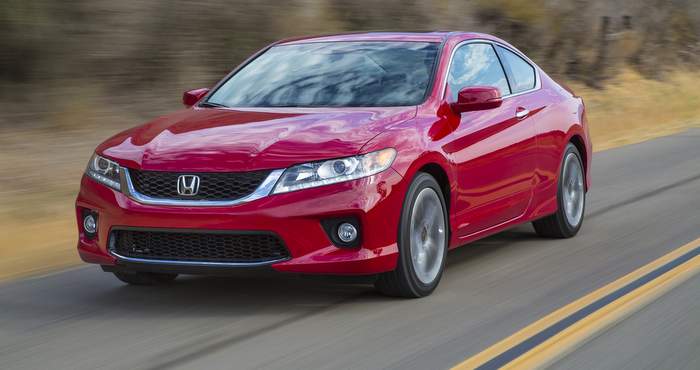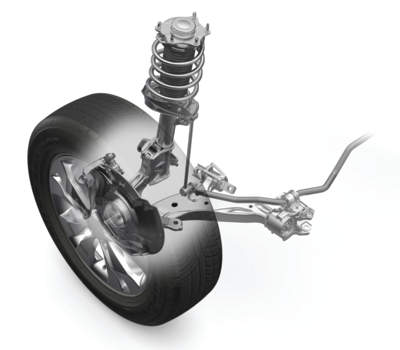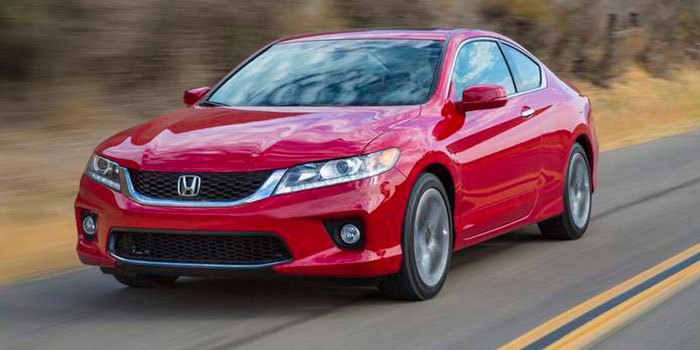
For this article, we find ourselves under a high-mileage V6 Honda Accord looking for what should be an easy-to-find knocking noise. When the car was written up at dropoff, notes were added for the tech to look for loose sway bar links and bushings based on the customer’s description of a knocking noise over bumps.
While the mileage was high, we’ve serviced this car for years and knew the customer took good care of it. After the initial road test, the tech agreed that it sounded like a sway bar-related problem and it was loud enough that it shouldn’t be difficult to pinpoint. Both the tech and customer agreed it was coming from the right-front.
Our first step with complaints of this type is to rock the car from side to side. By loading and unloading the suspension, most noises are easily heard and can be confirmed in short order with the help of a stethoscope and creeper. This technique also works well to pinpoint the “bed spring”-type squeak that you’ll hear with a rusted tight ball joint, tie rod end or a cracked spring.
Well, our Accord was dead quiet. We put it on the lift and gave it a good inspection. There was no play in the steering linkage and no cracked springs, so we started looking for things like loose subframe hardware or signs of movement where the control arm mounts.
There was no sign of movement, the hardware was tight and, for a high-mileage vehicle from the northeast, the bushings were in surprisingly good shape. We had replaced the front struts about 10,000 miles ago, so we looked closely there, but everything looked good. At this point, the other techs are putting fresh eyes on the problem, along with the tech who road tested the vehicle, who is surprised they can’t find anything based on the noise he heard on the road. We decided to pull it out for yet another road test.
As the tech and I pulled out of the lot, we got a sold thud as the right wheel contacted the irregular pavement. While on the smooth road, the car drove well with no noise. Next, we went out on our favorite road that’s in ill repair, looking for noises that are the result of something being loose, maybe sway bar links or bushings on the bars or control arms. This is also a perfect time to confirm the noise isn’t brakerelated.
In extreme cases, steering components could be the source of the noise. But, most of the time, you’ll see it is loose ball joints and tie rods during the on-lift inspections you should be doing on every car that goes in the air.
As I expected, we didn’t get much noise out of our Accord on the rough road portion of our road test. There was an occasional slight noise, but it wasn’t as solid as when we pulled out of the parking lot, and it didn’t have the consistency that we’ve come to expect from looseness. Not too surprising since it passed the rocking test in the bay.
I did take the time to explain to the young tech how important it is to consider road surface and the resulting noise while you are road testing and think about what the components are doing as they go over the surface. Does the wheel drop away unloading the suspension momentarily before the noise occurs, or is it the loaded suspension compressing? I asked him where he heard the noise this morning and we headed to the railroad crossing. Sure enough, even with slowing for the track, there was solid thud at the right-front, and a couple of trips over the tracks confirmed the condition and when it happened.
Talking to the tech on the way back to the shop, we discussed what could be making such a distinct sound that we hadn’t already checked. We were pretty sure it wasn’t in the suspension after all the rocking, pushing and jacking we did during the initial inspection. We were thinking it had to do with the axle as it plunges inward, while the wheel is moving upward.
The vehicle went back on the lift so we could double-check the hardware for the intermediate shaft, and everything was good there. With the axle nut removed, we were able to push the CV joint through the hub, and the axle plunged through its full travel as smooth as could be. That led us to look harder at the motor mounts. There were signs of metal-to-metal contact, but no other symptoms that the mount was bad enough to cause this noise. With frustration mounting, we pulled the car out to think about this some more.
When it hit the driveway apron on its way in we heard the noise again. We asked the tech driving the car to back out and come back in, and, sure enough, we got the noise every time. After another futile inspection, we supported the hood with a hood rod and watched as the car was driven over the apron. We pinpointed the noise to one area under the hood so we could concentrate our efforts.
After watching how the engine reacted to being driven over the bump, one of the techs grabbed a floor jack and a piece of wood, and with a little pressure on the oil pan you could see movement where the motor mount bracket on the right side (at the timing belt) attaches to the chassis mount.
It took us awhile to track this one down, but all it took to fix this was the tightening of a couple of bolts. Needless to say, we won’t forget to take some load off of the mounts if we’re faced with another one of these tough noise problems. This certainly isn’t a common Honda problem; most noises will be traced to sway bar systems.
On higher-mileage cars, you’ll see loose ball joints and tie rod ends during your undercar inspections. On the Pilot SUVs, we’ve seen some noisy rear shocks. On our problem Accord, we traced the noise back to timing belt service that was performed about 8,000 miles ago. I suspect the bolts were snugged down and never tightened. I’m always pushing good work habits, and here’s another learning experience and good opportunity to remind everyone to keep their focus on the job at hand.
 UNSUSPECTING NOISE CULPRITS
UNSUSPECTING NOISE CULPRITS
Speaking of timing belt jobs resulting in what would be considered undercar problems, there have been numerous reports of Hondas having power steering noise complaints shortly after the belt has been serviced. The complaint is a noise that sounds like the fluid is low, resulting from air in the system. Like many other manufacturers, Honda incorporates a screen filter at the bottom of the power steering reservoir that has been known to restrict flow to the pump, presenting the same symptoms as low fluid since the fluid can’t get into the system. In a pinch, the reservoir can be cleaned, but the screen filter isn’t very expensive, so it’s best to replace it, and perform a fluid flush with the correct fluid.
The other more common cause of noise after a timing belt replacement is air being drawn into the system at the inlet line O-ring at the pump. Whenever the pump is removed or even moved out of the way during a procedure, it’s a good idea to order and replace this O-ring.
Getting back to the suspension, I mentioned the “bed spring” noise earlier, but I want to bring it up again since it can be more of a safety issue than the sway bar noises. Very little suspension movement is needed to cause this noise — a simple lean on the fender, or getting in the driver’s seat will bring it on. Again, a stethoscope will help in pinpointing the offending joint, or you can feel the vibration in the joint as the suspension moves.
In a majority of cases, you’ll find that one of the lower ball joints is the problem. Some will have damaged boots where water has found its way into the joint, causing the rust that tightens up the joint and results in the noise. While this can be an intermittent problem at first, it shouldn’t be ignored. The safety issue comes into play as the strength of the joint is compromised by rust, which causes the joint to come apart, and nobody wants that.
Another common Honda undercar issue is wheel-bearing noise, or what your customer describes as a growling noise as the car is being driven. This can be tricky to diagnose since tire noise and other driveline bearing failures cause similar symptoms. To narrow it down to the wheel bearings during the road test, shift the weight from one side of the vehicle to the other with light steering inputs with side-to-side movements; as the load changes, so will the sound. Of course, any road test diagnosis should be confirmed at the shop.
The front bearings are directional since they contain the encoder for the wheel speed sensor. Identified by the color of the seal, the inboard seal is usually brown, but if there is paperwork in the box be sure to read it.
If you’re in one of the 4WD SUVs, the center bearing and U-joints in the rear driveshaft have to be considered along with the rear differential and transfer case. If you’re faced with chattering-type noises while turning, change the rear differential oil with the approved fluid before going any further.
Be sure to perform the undercar inspection so any problems found there can be considered while pricing out the wheel bearing. If the vehicle needs suspension work, brakes or an axle, this is the time to point it out and give the customer a chance to take advantage of the labor savings that should be available by bundling the jobs.
When it comes to the brake systems on Hondas, the ABS system has proven to be very reliable with only the occasional failure of a wheel speed sensor; some of these are broken wires that are repairable.
Here in the northeast, it’s not uncommon to encounter bad calipers on the high-mileage cars. This seems to be a bigger problem with the Accords and Acuras, but if there is any question, it pays to be sure that the calipers are serviceable before the job is sold and parts are ordered. Hopefully you have already adopted the procedure of opening the bleeder valves before pushing back the pistons and flushing the fluid while performing the bleeding process.
In most of my articles, I talk about how important it is to have a scan tool with enhanced capabilities for the cars you work on. While factory tooling is nice to have, there are enough aftermarket options available today that there is no reason your shop shouldn’t have one. While you won’t need it for the suspension work, you won’t be able to handle ABS diagnosis without one.
Honda uses a system it calls Vehicle Stability Assist (VSA) as a driver’s aid that will make braking decisions based on the ABS wheel speed, steering angle, brake input and the pitch and yaw sensors to make it easier for the driver to control the vehicle. Not only is the scanner necessary to diagnose the system, it’s also required to reset the sensors to their neutral positions should the memory be lost.
Courtesy ImportCar.














